| Article ID | Journal | Published Year | Pages | File Type |
|---|---|---|---|---|
| 2566531 | Progress in Neuro-Psychopharmacology and Biological Psychiatry | 2007 | 12 Pages |
Impaired inhibitory processing has been implicated in clinical expressions of impulsivity, but it is unknown whether the same deficit underlies the personality trait in healthy, non-clinical populations. The present study examined performance and event-related potentials (ERPs) during a stop-signal task in non-clinical adults who scored in the top (“Low” n = 20) and bottom 15% (“High” n = 20) on Eysenck's Impulsiveness Questionnaire from a sample of 200 subjects. The stop-signal task consisted of a visual choice-RT task and auditory stop-signals presented on 30% of trials. While performance findings revealed no differences between groups, underlying ERPs revealed a number of quantitative differences. Lateralised readiness potential (LRP) amplitude on stop-signal trials was larger in the High than Low group, indicating greater response side-specific motor preparation in the primary motor cortex (PMC), while an N1/P3 complex was evoked on successful stop-signal trials and was also enhanced in the High than Low group. The centrally-maximal successful-stop P3 has previously been implicated as an index of inhibition in the PMC, suggesting enhanced inhibitory processing in the High group. Together these findings indicate that the High impulsivity group was able to counteract an impulsive response style on stop-signal trials with enhanced inhibitory activation, resulting in comparable overt performance to the Low group. These results provide a unique insight into the neural mechanisms underlying trait impulsivity in non-clinical adults.
